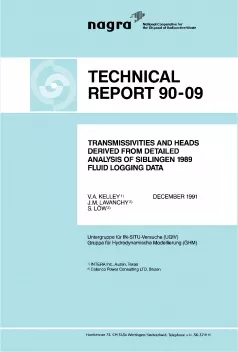
Technical Report NTB 90-09
Transmissivities and heads derived from detailed analysis of Siblingen 1989 fluid logging data
The Siblingen borehole was drilled by the Swiss National Cooperative for Radioactive Waste Disposal (Nagra) to hydraulically characterize granitic basement rocks of northern Switzerland for their potential for the safe storage of high-level radioactive waste. The Siblingen crystalline section of the borehole was tested with an extensive set of hydraulic packer tests and geophysical methods. In addition, the borehole was tested from the interval 525 to 1522 m below ground (b.g.) with non-standard fluid logging techniques.
The fluid logging methods used in Siblingen were the spinner flowmeter (SF), the spinner-packer flowmeter (SPF), the heat-pulse packer flowmeter (HPPF), and temperature and electrical conductivity logging (T/LF). This report presents the detailed analysis of these various fluid logging methods. The result from each fluid logging method is the estimation of the borehole volumetric flow rate as a function of depth. In addition, through electrical conductivity logging discrete isolation of inflowing features is possible. Through fundamental hydraulic analysis these measurements can be used to estimate interval transmissivity and in certain cases interval head. These calculations were performed for all suitable logs. A complete description of analysis methods is included prior to each step of analysis.
A comparison between the various fluid logging methods is made through a review of the analysis results (transmissivities and heads). A comparison between the transmissivities and heads calculated by fluid logging and measured by hydraulic tests is made. In general, the fluid logging techniques predicted transmissivity to within a factor of two when compared to hydraulic tests. The two most accurate fluid logging methods, as defined by hydraulic tests, were conductivity logging and the heat-pulse packer flowmeter for the conditions prevailing in Siblingen during testing. The fluid logging methods gave head estimates which were not in strict agreement with hydraulic test results but are within the variation in observed measurements.
The application of fluid logging methods for the characterization of the Siblingen crystalline has been successful in determination of major transmissive areas (defined as rock having a transmissivity greater than 1E-9 m2/s). In addition, these methods have identified (to within ± 1 m) 13 individual inflow regions within the lower crystalline (1000 to 1522 m b.g.). Fluid logging methods represent a compatible borehole testing method to hydraulic packer tests in allowing for a focused use of hydraulic packer tests. In addition, conductivity logging can be used to attribute discrete intervals to transmissivity measurements.
